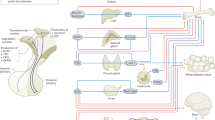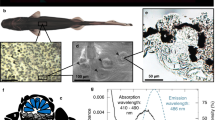Abstract
IT has been reported by Johnsson and Högberg1 and Sulman2 that some purified preparations of pituitary adrenocorticotrophic hormone have a strong dispersing action on the melanocytes of Rana temporaria and Hyla arborea, like the pituitary melanotropic hormone (intermedin), and from this and other arguments1 they infer the identity of these hormones. However, later observations by Geschwindt et al. 3, Morris4 and Lock5 do not seem to be consistent with the hypothesis of Johnsson and Högberg1 and Sulman2, as (a) the melanotropic action of adrenocorticotrophic hormone could be separated from the corticotrophic, and (b) the treatment with 0.1 N alkali destroys the latter action to a large extent but leaves relatively unaffected or even potentiates the melanophore expanding action. If Johnsson and Högberg1 and Sulman's2 assumption were correct, highly purified preparations of intermedin would prevent, like adrenocorticotrophic hormone, the changes in the adrenals following hypophysectomy and restore the glands to their normal structure. In the toad Bufo arenarum Hensel, thirty days after complete removal of the pituitary, the adrenals appear atrophied, as the trabeculæ become thinner and the cortical cells lose most of the osmiophilic droplets (Fig. 1) observed in the normal controls (Fig. 2). If fifteen days after the hypophysectomy a daily injection of 100 µgm./100 gm. toad weight of adrenocorticotrophic hormone (from Armour and Co., lot J–80211) is started and continued for the following fifteen days, then the adrenals show again the thick trabecular structure and the cortical cells loaded with medium- and large-sized osmiophilic granula (Fig. 3). In the toads similarly injected with intermedin (LRW 1 extract of Landgrebe et al. 6), the conditions of the adrenals (Fig. 4) is the same as in the hypophysectomized non-injected toads, which proves that intermedin cannot replace the action of adrenocorticotrophic hormone on the adrenals.
This is a preview of subscription content, access via your institution
Access options
Subscribe to this journal
Receive 51 print issues and online access
$199.00 per year
only $3.90 per issue
Buy this article
- Purchase on Springer Link
- Instant access to full article PDF
Prices may be subject to local taxes which are calculated during checkout
Similar content being viewed by others
References
Johnsson, S., and Högberg, B., Nature, 169, 286 (1952).
Sulman, F. G., Nature, 169, 588 (1952).
Geschwindt, I. I., Reinhardt, W. O., and Li, C. H., Nature, 169, 1061 (1952).
Morris, C. J. O. R., Lancet, i, 1210 (1952).
Lock, J. A., Lancet, ii, 147 (1952).
Landgrebe, F. W., Reid, E., and Waring, H., Quart. J. Exp. Physiol., 32, 121 (1943).
Stoppani, A. O. M., J. Pharmacol., 76, 118 (1942).
Sayers, G., White, A., and Long, C. N. H., J. Biol. Chem., 149, 425 (1943).
Hogben, L. T., “The Pigmentary Effector System”, 62 (Oliver and Boyd, London, 1924).
Houssay, B. A., and Ungar, I., Rev. Soc. Argent. Biol., 5, 173 (1924).
Hogben, L. T., and Gordon, C., J. Exp. Biol., 7, 286 (1930).
Author information
Authors and Affiliations
Rights and permissions
About this article
Cite this article
STOPPAKI, A., PIERONI, P. & MURRAY, A. Non-Identity of Intermedin and Adrenocorticotrophic Hormone. Nature 172, 547–548 (1953). https://doi.org/10.1038/172547a0
Issue Date:
DOI: https://doi.org/10.1038/172547a0
Comments
By submitting a comment you agree to abide by our Terms and Community Guidelines. If you find something abusive or that does not comply with our terms or guidelines please flag it as inappropriate.



